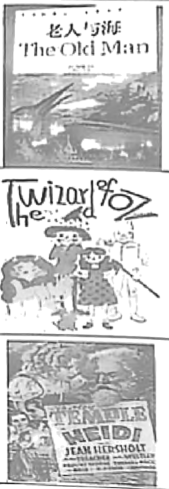
The United Nations has 6 official (官方的) languages. Each of them has their own days with the aim to show the rich history and culture (文化) of each language. UNESCO first created (创造) Chinese Language Day in 2010 to celebrate Chinese as one of the six official languages of the United Nations.
The first Chinese Language Day was on November 12th. But since 2011, it has been on the April 20th. The date was chosen from Guyu to remember Cangjie. Cangjie is very important in Chinese culture. People believed he created Chinese words 5,000 years ago. In old stories, it’s said that Cangjie had 4 eyes and he was good at observing (观察). He often watched the sun and the moon with his upper 2 eyes, and mountains and rivers with the lower 2 eyes. His long-time observation made him create the earliest written words according to the shape of things.
On Chinese Language Day, there are different activities to celebrate the Chinese language and the theme (主题) is different each year. In 2022, “China Chic” was chosen as the theme. Chen Xu, an officer said, “Choosing this theme, we hope to spread what most of Chinese people like today so that foreigners can know more about Chinese culture and have a better understanding of China.” A video festival called “Foreigners look at China Chic” was held. In the videos, foreigners showed their love of Chinese fashion.
Chinese Language Day is an important carrier for Chinese learners, lovers, and users from all over the world to get close to Chinese. Nowadays, more than one sixth of world’s population speak Chinese as their first language—that’s more than any other population in the world! Learning Chinese is more like a key to knowing China and feeling the beauty of Chinese culture.
1. The Chinese Language Day was first created _______.| A.in 2011 | B.13 years ago | C.to celebrate Guyu | D.to remember Cangjie |
A. | B. | C. | D. |
| A.Make something cheap. | B.Make something beautiful. |
| C.Make something popular. | D.Make something traditional. |
| A.To tell some facts about a language day. |
| B.To make foreign people love to visit China. |
| C.To tell stories about a famous man Cangjie. |
| D.To show the history of the language of Chinese. |
相似题推荐
【推荐1】Perhaps you have seen some strange English before, like “big meter” for dami and “small buy” for xiaomaibu in Chinese. These are examples of incorrect translations (翻译) in China. They can be seen everywhere.
While many people find this “Chinglish” to be funny, it also confuse (使困惑) English speakers. On Dec 1, China carried out its first national standards (规范) for the use of English in public service areas. The standards include more than 13 areas, including transportation, sports and education. This means that many Chinese words will now have standard English names.
For example, the English words for the Chinese dishes huntun and lamian are “wonton” and “lamian noodles”. For kaochuan and mixian, the English names are “barbecue” and “rice noodles”.
As for places, shaoniangong is called “children’s palace”. The entertainment activity nongjiale that we enjoy in rural areas is called “agritainment”. There are also many English warning (警示) phrases.
The standards are part of efforts China has made in past years to fix incorrect English. Many cities have already fixed signs with poor English translations. Shanghai opened a 12345 hotline to encourage people to report incorrect translations.
1. Which of the following is correct about the national standards? ________
| A.They was carried out on Jan 1, 2017. |
| B.They are China’s first translation dictionaries, |
| C.They have 3, 500 English-to-Chinese translations. |
| D.They give many Chinese words standard English names. |
| A.malatang. | B.lamian. |
| C.hundun. | D.kaochuan. |
| A.a rural place | B.an entertainment activity |
| C.a warning sign | D.a place for kids |
| A.To fix incorrect English. |
| B.To teach English speakers. |
| C.To improve other countries’ images. |
| D.To help more people learn English. |
| A.some cities have already corrected all the signs |
| B.all the cities have corrected lots of signs |
| C.lots of wrong English translation signs have been fixed in many cities |
| D.correct translations in China can be seen everywhere |
【推荐2】Do you find it hard to describe a person? Don’t worry. These characters from famous books will help you.
Persevering Meaning: A persevering person never gives up his or her dream in spite of (尽管) difficulties. Example: In the book The Old Man and the Sea, the old fisherman Santiago doesn’t catch any fish in 84 days, but he doesn’t give up. Finally he succeeds in catching a big marlin. |  |
Adventurous Meaning: An adventurous person is brave and willing to take risks. Example: In the book The Wizard of Oz, the girl Dorothy takes the Scarecrow, the Tin Woodman, and the Lion to the Land of Oz. Their journey is full of adventure. | |
Isolated Meaning: If someone is isolated, he is used to living alone. Example: In the book Heidi, Uncle Alp lives alone in the mountains before the lovely girl Heidi comes here. Others don’t like to meet and speak to him. |
| A.The marlin is Santiago’s pet. |
| B.Dorothy is brave enough to take adventure. |
| C.Heidi is too shy to speak to Uncle Alp. |
| A.To show a way to learn words. |
| B.To share some famous books. |
| C.To give examples on personalities. |
| A.Pronunciation | B.Grammar | C.Vocabulary |

NEW word in 2020
Coronavirus is this year’s Children’s Word of the Year. This is very interesting given that the 500 Words competition closed on 27 February 2020, the day before the first case was documented in the UK. This shows the influence of important events around the world on children’s creativity.
Highlights
The word coronavirus appeared for the first time in the 500 Words stories in 2020. It is not a word that has been used before.
The word has been used 459 times in the stories in 2020, with 287 of them as coronavirus, 168 as corona virus, and 4 as corona-virus.
It is amazing that many of the themes young writers explored in fiction soon became a reality with the world in lockdown.
Examples
The nurses came running over. I felt a pain in my neck, I started to gasp for air. My body started shaking I couldn’t control myself. My eyes rolled to the back of my head, a mask covered my mouth, my temperature raised and I have the coronavirus.
(The Ex, girl 13)
A few years later he finally landed on earth ... but when he landed he found out a deadly virus had struck earth, the corona virus ...
(Bob’s Trip Around the Universe, boy 10)
1. This passage is most probably part of ________.| A.a language report | B.a science report |
| C.a book review | D.a film review |
| A.a 2019 survey | B.a 2020 survey |
| C.a 2019 competition | D.a 2020 competition |
| A.Most children like the word very much. | B.Most children use the word very often. |
| C.Children first used it in stories this year. | D.Children first used it in stories years ago. |
【推荐1】Where do the colors of your clothes come from? The answer is dye (染料). The clothes we wear today are mainly dyed with chemicals (化学物质). But in the past, people did this by hand and the dyes often came from plants.
With a history of more than 1, 000 years, tie-dye (扎染) is a very old way of dyeing clothes in China. During Tang and Song dynasties (朝代) this skill became so popular that people gave tie-dyed clothes to the emperor as gifts.
To tie-dye, you first need to use threads (线) to tie your cloth together. Then put the cloth into the dye. As the cloth is folded and dyed, some parts become dark blue, while other parts have a lighter color. When you spread the cloth, you’ll see beautiful patters.
Yang Cheng, 52, is the inheritor (传承人) of tie-dye in Anning, Yunnan. He learned the skill from his mother in the 1980s. Yang has mastered (掌握) all the old skills of tie-dye. And he has handed them down to his daughter. At the same time, Yang has studied tie-dye in other countries, such as Japan, India and France. He also tries to make some creative designs. Now, Yang teaches tie-dye in schools and communities. More than 100, 000 people have learned from him.
Some might worry that tie-dye will be replaced by machinery dyeing. But Yang is confident. “At the end of the day, machines can’t replace our creative hands,” said Yang.
1. The first paragraph is written to ________.| A.explain why clothes are colorful | B.lead into the topic of the passage |
| C.introduce where dye comes from | D.show different kinds of dye |
| A.use different kinds of blue dye | B.put different-colored cloth together |
| C.mix both dark and light dye | D.fold the cloth before dyeing it |
| A.could only be used by emperors before | B.came from plants |
| C.is a skill to make colorful clothes | D.first appeared in Tang Dynasty |
| A.make him more well-known |
| B.show the bright future of tie-dye |
| C.encourage people to learn tie-dye from him |
| D.introduce more about the development of tie-dye |
| A.Magic Patterns Still Shine Today | B.A Successful Artist |
| C.Learning is a Lifelong Journey | D.The Way Out for Traditional Culture |
【推荐2】Lihn, a Vietnamese woman, recently became a big fan of Chinese actor Zhao Youting, who acts in the Chinese TV series To the Sky Kingdom. She even bought the same clothes as Zhao wears in the TV series. This shows Vietnamese people’s love for Chinese TV dramas.
According to a study, since 2012, more than 1,600 Chinese films and TV shows have been played in more than 100 countries and translated into 36 languages, including English, French and Russian. Most of them go to Asian countries such as Japan, South Korea and other countries with similar culture.
Chinese costurne dramas(古装剧)have always been the most popular among foreigners. For example, Nirvana in Fire, which caught fire in China in 2016, successfully broke into the markets in Japan and South Korea. A South Korean travel company even designed a tour themed on the drama.
Also, family dramas have been hot in recent years in both neighbouring countries and Africa. Africans, like us, value their family a lot. It is very common to see generations(世代)living together in Africa. Many situations in Chinese family dramas resonate(共鸣)with African women. They wonder how women in other countries would deal with similar headaches in everyday life. The dramas work as an important window for them to understand Chinese culture.
1. What does the first paragraph mainly tell us?| A.Zhao Youting is an excellent actor. |
| B.Lihn loves beautiful clothes. |
| C.To the Sky Kingdom is a great TV series. |
| D.Vietnamese women love Chinese dramas. |
| A.Because they like Chinese family life. |
| B.Because they want to understand Chinese programmes. |
| C.Because they would like to take a trip to China. |
| D.Because they wonder how Chinese solve daily problems. |
| A.Why Chinese TV series are popular in Africa. |
| B.What we can do to improve Chinese TV series. |
| C.Chinese TV series are popular in many countries. |
| D.We should spread our national culture abroad. |
【推荐3】Classic Chinese cartoons bring joy to most of us. Last year, six classic Chinese cartoons came out on the video platform again. Let’s see how old artists put Chinese culture and art into the cartoons to make them classic.
 | The Legend of Sealed Book tells the story of the boy Dansheng. He practices great tricks from the book to help people. The film uses face makeup from the Peking Opera. It helps to show the characters’ personalities. Lovely Dansheng looks like wawasheng, roles for kids in Peking Opera. A bad person looks like a clown, with a large white part in the center of his face. |
 | Little Tadpole Looking for Mummy is China’s first ink wash cartoon. Artists drew all the animals, plants and rocks with ink and brush. They learned from the great artist Qi Baishi. Though it’s only about 15 minutes long, it took lots of work. Artists drew everything by hand. One second of the cartoon needed 24 pictures! The 2020 cartoon series Fog Hills of Five Element also uses this style. |
 | Pigsy Eats Watermelon is China’s first paper cutting cartoon. This 15-minute cartoon came out in 1958. Artists cut Zhu Bajie out of colored paper. Then they moved its body parts and let it eat the watermelon. Making a paper cutting cartoon was not easy. The artists failed at first. The characters’ moves were not stable (平稳的). After more work, they tried again and finally did it! |
| A.It is the only ink wash cartoon in China. |
| B.Artists did lots of work to make this cartoon. |
| C.Artists finished this 15-minute cartoon quickly. |
| D.Qi Baishi helped draw some of the pictures in cartoon. |
| A.It was hard to make the characters’ moves stable. |
| B.Artists couldn’t cut out the paper in the correct form. |
| C.They didn’t have enough time to check the paper cutting. |
| D.They didn’t know how to stop their characters from moving. |
| A.They are all 15-minute cartoons. |
| B.All of them are stories about animals. |
| C.They all use the style of traditional Chinese art. |
| D.The characters in these cartoons have same personalities. |
| A.Cartoons in the future | B.The best cartoon in the world |
| C.Bringing back the classics | D.Studying traditional arts together |
【推荐1】Let’s suppose it is a common day of 2060. Of course, things have changed and life is very different.
Trips to the moon are being made every day. Taking a holiday on the moon today is as easy as taking a holiday in Europe in the 2010s. At a number of scenic spots (风景胜地) on the moon, many hotels have been built. In order that everyone can enjoy the beautiful scenery on the moon, every room has at least one picture window. Everything imaginable is provided for entertainment of the young and old.
What are people eating now? People are still eating food. But a lot of food now comes in pill (药片) form, and the food that goes into the pill comes mainly from green plants.
Because people in the world today are much more than those about fifty years ago, most of the earth's surface has to be filled. The deserts are irrigated with water and crops are no longer eaten by pests (害虫). The harvest is always good. Farming, of course, is very highly developed. Very few people have to work on the farms. It is possible to run the farms by just using a few computers.
People are row largely vegetarians, and they eat only bread, vegetables, fruit and so on and they don’t eat meat or fish. You see, as the number of people increases, the number of animals decreases. So people have to be vegetarians. We are healthier both in our bodies and in our minds, and we know how to deal with all kinds of illnesses. No one has to be ill any more.
1. What will be on the moon in 2060 according to the passage?| A.Many green plants. |
| B.Many wild animals. |
| C.Many interesting places |
| D.Many children and students. |
| A.冲刷 | B.灌溉 | C.淹没 | D.排泄 |
| A.People only eat food in pill form. |
| B.People don’t have any crops. |
| C.People run the farms by using high technology. |
| D.The harvest is sometimes good. |
| A.Because they want to be healthier. |
| B.Because vegetables can make the patients well. |
| C.Because there will be more people and fewer animals. |
| D.Because eating vegetables is good for our minds |
| A.He feels pretty hopeful about the future. |
| B.He is not very satisfied with some things of the future. |
| C.He seems really sad about what will happen in the future. |
| D.He is afraid of the future life |
Here at the mouth of a river there is much important plant and animal life. But pollution destroys this life. We have to clean our rivers. Man has to work with nature, not against it.
1. Water is like________.
| A.clouds | B.blood | C.life |
| A.Blood | B.Water | C.Salt |
| A.the sea | B.a lake | C.a mountain |
| A.head | B.top | C.mouth |
| A.find | B.clean | C.pollute |
【推荐3】Suppose what people will eat in 30 years’ time? Here are a few possible answers.
 Insects | Insects take up little space and don’t make much waste. They also have more protein than beef, chicken and pork. This makes insects another possible food of the future. |
 Vegetable meat | A new kind of hamburger is now popular in the US. It looks the same as other hamburger, and so is the taste. But it’s actually a “beef” burger made out of plants. The company called Impossible Foods uses peas and potatoes to make the “beef”. They take coloring, protein and fats from these plants and mix them together. |
 Algae(藻类) | The BBC says algae farming could become the world’s biggest farming industry in the future.They point out that algae is cheap and grows very quickly. What’s more, it’s very nutritious. It has much more protein and oil than any other plants. Besides eating algae as a dish on its own, people may also use algae oil and algae butter in the future. Algae has a strong taste. The UK scientists are trying to use algae to take the place of salt. |
根据材料内容选择最佳答案。
1. What do insects, vegetable meat and algae include in common?
| A.Protein. | B.Oil. | C.Fats. | D.Salt |
| A.insects and algae | B.peas and potatoes |
| C.chicken and pork | D.beef and chicken |
| A.漂亮的 | B.丑陋的 | C.有营养的 | D.没营养的 |
| A.Sweet. | B.Sour | C.Strong | D.Bitter. |
| A.The Food in the Future. | B.Three Kinds of Food. |
| C.There Will Be Less Food in the Future | D.Insects Will Be Delicious Food in the Future. |



